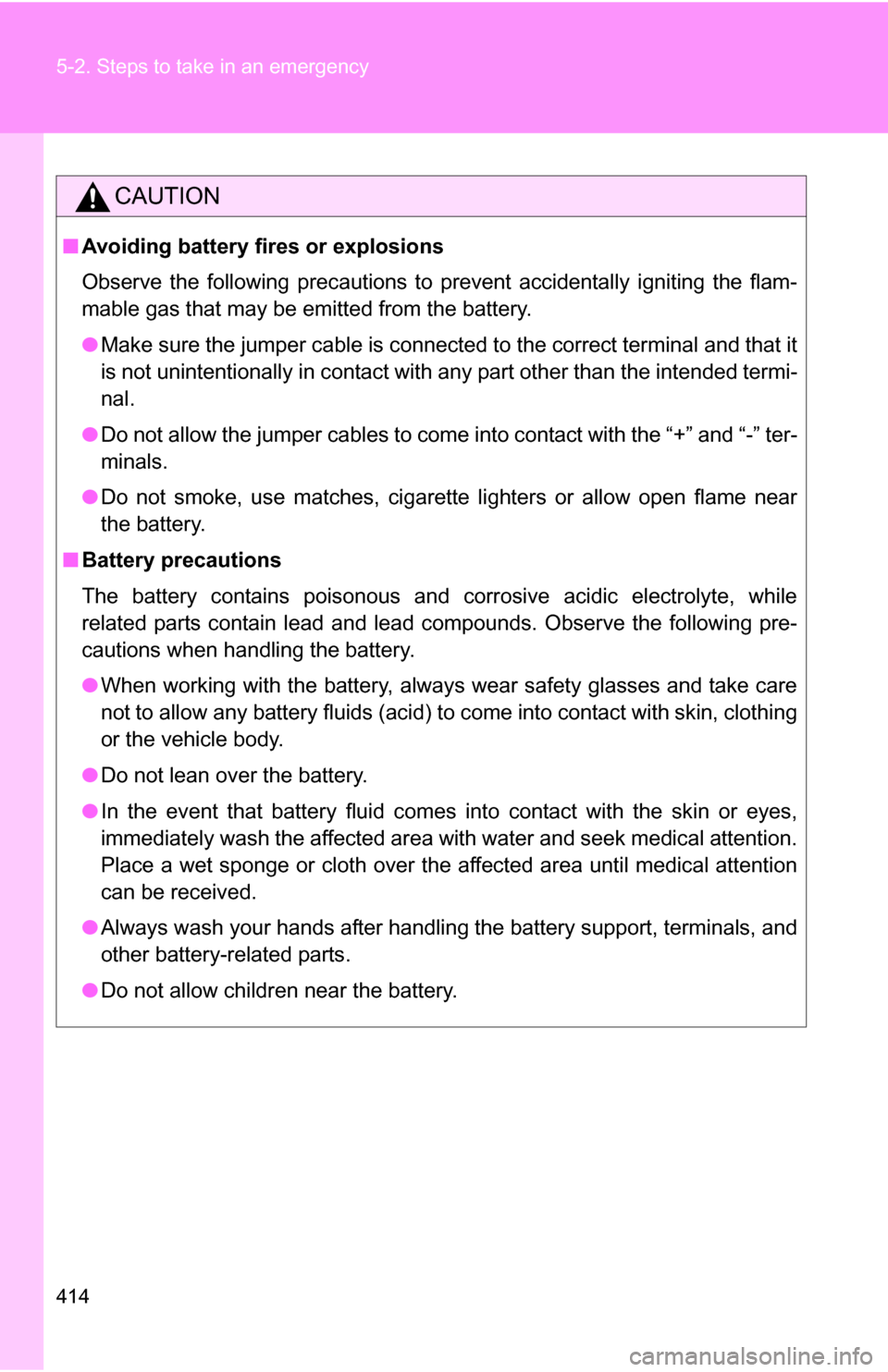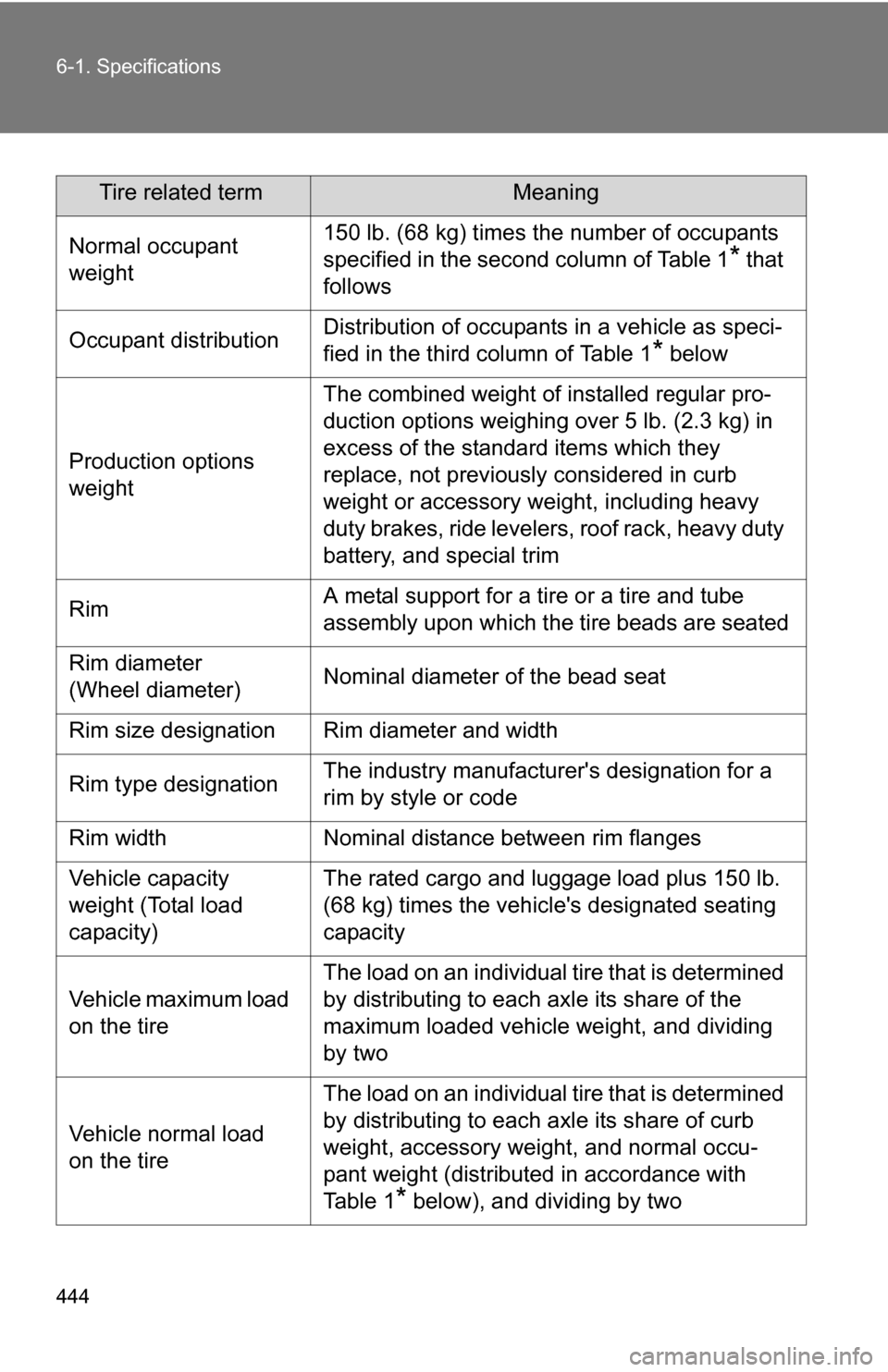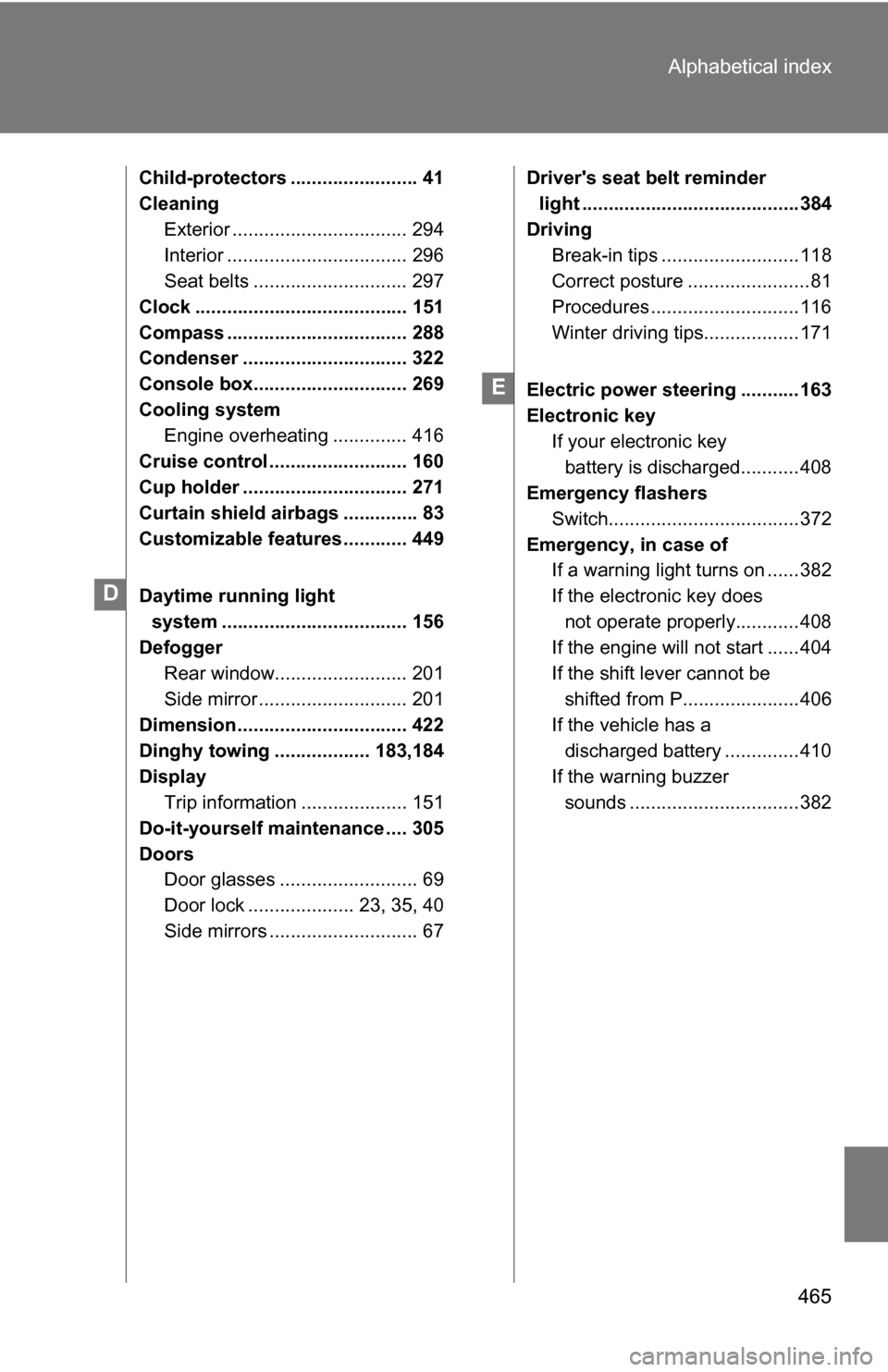Page 411 of 476
5
When trouble arises
411
5-2. Steps to take in an emergency
Connecting the jumper cables
Positive (+) battery terminal on your vehicle
Positive (+) battery terminal on the second vehicle
Negative (-) battery terminal on the second vehicle
Connect the jumper cable to ground on your vehicle as shown in
the illustration. Start the engine of the second vehicle. Increase the engine
speed slightly and maintain at that level for approximately 5
minutes to recharge the battery of your vehicle.
Vehicles with smart key system: Open and close any of the
doors with the “ENGINE START STOP” switch OFF.
Maintain the engine speed of the second vehicle, and turn
the “ENGINE START STOP” switch to IGNITION ON mode
(vehicles with smart key system) or turn the engine switch
to the “ON” position (vehicles without smart key system),
then start the vehicle's engine.
STEP 2
STEP 3
STEP 4
STEP 5
Page 412 of 476
412 5-2. Steps to take in an emergency
Once the vehicle’s engine has started, remove the jumper
cables in the exact reverse order in which they were con-
nected.
Once the engine starts, have the vehicle checked at your Toyota
dealer as soon as possible.
2.4 L 4-cylinder (2AZ-FE) engine
Connecting the jumper cables Positive (+) battery terminal on your vehicle
Positive (+) battery terminal on the second vehicle
Negative (-) battery terminal on the second vehicle
Connect the jumper cable to ground on your vehicle as shown in
the illustration. Start the engine of the second vehicle. Increase the engine
speed slightly and maintain at that level for approximately 5
minutes to recharge the battery of your vehicle.STEP 6
STEP 1
STEP 2
Page 413 of 476
5
When trouble arises
413
5-2. Steps to take in an emergency
■
Avoiding a discharged battery
●Turn off the headlights and the audio system while the engine is turned
off.
● Turn off any unnecessary electrical components when the vehicle is run-
ning at a low speed for an extended period, such as in heavy traffic, etc.
Maintain the engine speed of the second vehicle, and turn
the engine switch to the “ON” position, then start the vehi-
cle's engine.
Once the vehicle’s engine has started, remove the jumper
cables in the exact reverse order in which they were con-
nected.
Once the engine starts, have the vehicle checked at your Toyota
dealer as soon as possible.STEP 3
STEP 4
Page 414 of 476

414 5-2. Steps to take in an emergency
CAUTION
■Avoiding battery fires or explosions
Observe the following precautions to prevent accidentally igniting the flam-
mable gas that may be emitted from the battery.
●Make sure the jumper cable is connected to the correct terminal and that it
is not unintentionally in contact with any part other than the intended termi-
nal.
● Do not allow the jumper cables to come into contact with the “+” and “-” ter-
minals.
● Do not smoke, use matches, cigarette lighters or allow open flame near
the battery.
■ Battery precautions
The battery contains poisonous and corrosive acidic electrolyte, while
related parts contain lead and lead compounds. Observe the following pre-
cautions when handling the battery.
●When working with the battery, always wear safety glasses and take care
not to allow any battery fluids (acid) to come into contact with skin, clothing
or the vehicle body.
● Do not lean over the battery.
● In the event that battery fluid comes into contact with the skin or eyes,
immediately wash the affected area with water and seek medical attention.
Place a wet sponge or cloth over the affected area until medical attention
can be received.
● Always wash your hands after handling the battery support, terminals, and
other battery-related parts.
● Do not allow children near the battery.
Page 429 of 476
429
6-1. Specifications
6
Vehicle specifications
Electrical system
Manual transaxle
Automatic transaxle
Battery
Open voltage at
68
F (20 C): 12.6 12.8 V Fully charged
12.2 12.4 V Half charged
11 . 8
12.0 V Discharged
(Voltage checked 20 minutes after the
engine and all the lights turned off)
Charging rates 5 A max.
Gear oil capacity (reference) 1.8 L 4-cylinder (2ZR-FE) engine
2.0 qt. (1.9 L, 1.7 Imp. qt.)
2.4 L 4-cylinder (2AZ-FE) engine
2.6 qt. (2.5 L, 2.2 Imp. qt.)
Gear oil type API GL-4
Recommended gear oil
viscosity SAE 75W
Fluid capacity (reference) 1.8 L 4-cylinder (2ZR-FE) engine
6.9 qt. (6.5 L, 5.7 Imp. qt.)
2.4 L 4-cylinder (2AZ-FE) engine
8.2 qt. (7.8 L, 6.9 Imp. qt.)
Fluid type Toyota Genuine ATF WS
Page 444 of 476

444 6-1. Specifications
Tire related termMeaning
Normal occupant
weight 150 lb. (68 kg) times the number of occupants
specified in the second column of Table 1
* that
follows
Occupant distribution Distribution of occupants in a vehicle as speci-
fied in the third column of Table 1
* below
Production options
weight The combined weight of installed regular pro-
duction options weighing over 5 lb. (2.3 kg) in
excess of the standard items which they
replace, not previously considered in curb
weight or accessory weight, including heavy
duty brakes, ride levelers, roof rack, heavy duty
battery, and special trim
Rim A metal support for a tire or a tire and tube
assembly upon which the tire beads are seated
Rim diameter
(Wheel diameter) Nominal diameter of the bead seat
Rim size designation Rim diameter and width
Rim type designation The industry manufacturer's designation for a
rim by style or code
Rim width Nominal distance between rim flanges
Vehicle capacity
weight (Total load
capacity) The rated cargo and luggage load plus 150 lb.
(68 kg) times the vehicl
e's designated seating
capacity
Vehicle maximum load
on the tire The load on an individual tire that is determined
by distributing to each axle its share of the
maximum loaded vehicle weight, and dividing
by two
Vehicle normal load
on the tire The load on an individual tire that is determined
by distributing to each axle its share of curb
weight, accessory weight, and normal occu-
pant weight (distributed in accordance with
Ta b l e 1
* below), and dividing by two
Page 464 of 476

464 Alphabetical index
Back-up lightsReplacing light bulbs ............. 360
Wattage ................................. 433
Battery Checking ............................... 325
If the vehicle has a
discharged battery .............. 410
Preparing and checking
before winter ....................... 171
Bluetooth
®................................ 232
Bottle holder ............................. 275
Brake
Fluid ...................................... 322
Parking brake ........................ 141
Brake assist .............................. 163
Break-in tips ............................. 118
Care Exterior .................................. 294
Interior ................................... 296
Seat belts .............................. 297
Cargo capacity ......................... 167
Cargo hooks ............................. 287
CD changer ............................... 211
CD player .................................. 211
Chains ....................................... 171 Child restraint system
Booster seats, definition........ 100
Booster seats, installation ..... 104
Convertible seats, definition ............................. 100
Convertible seats, installation........................... 104
Front passenger occupant
classification system ............. 95
Infant seats, definition ........... 100
Infant seats, installation ........ 104
Installing CRS with LATCH anchors ............................... 105
Installing CRS with
seat belts ............................ 107
Installing CRS with top tether straps........................ 111
Child safety Airbag precautions .................. 90
Battery precautions ....... 327, 414
Child restraint system ........... 100
Child-protectors....................... 41
How your child should wear the seat belt .......................... 60
Installing child restraints........ 104
Moon roof precautions ............ 73
Power window lock switch ...... 69
Power window precautions ..... 70
Removed key battery precautions ......................... 349
Seat belt comfort guide ........... 57
Seat belt extender precautions ........................... 63
Seat belt precautions .............. 61
Seat heater precautions ........ 283
Trunk precautions ................... 48
B
C
Page 465 of 476

465
Alphabetical index
Child-protectors ........................ 41
Cleaning
Exterior ................................. 294
Interior .................................. 296
Seat belts ............................. 297
Clock ........................................ 151
Compass .................................. 288
Condenser ............................... 322
Console box............................. 269
Cooling system Engine overheating .............. 416
Cruise control .......................... 160
Cup holder ............................... 271
Curtain shield airbags .............. 83
Customizable features ............ 449
Daytime running light system ................................... 156
Defogger
Rear window......................... 201
Side mirror ............................ 201
Dimension ................................ 422
Dinghy towing .................. 183,184
Display Trip information .................... 151
Do-it-yourself maintenance .... 305
Doors Door glasses .......................... 69
Door lock .................... 23, 35, 40
Side mirrors ............................ 67 Driver's seat belt reminder
light .........................................384
Driving Break-in tips ..........................118
Correct posture .......................81
Procedures ............................116
Winter driving tips..................171
Electric power steering ...........163
Electronic key If your electronic key battery is discharged...........408
Emergency flashers
Switch....................................372
Emergency, in case of If a warning light turns on ......382
If the electronic key does
not operate properly............ 408
If the engine will not start ......404
If the shift lever cannot be
shifted from P......................406
If the vehicle has a
discharged battery ..............410
If the warning buzzer sounds ................................382
D
E